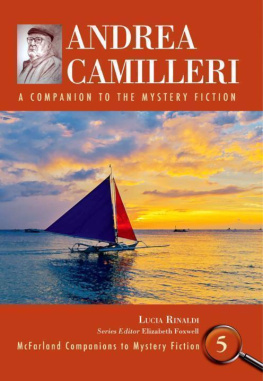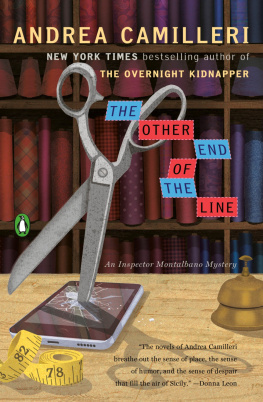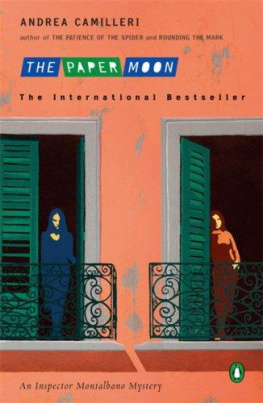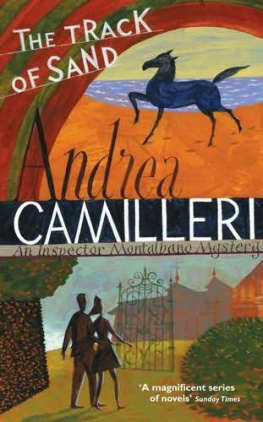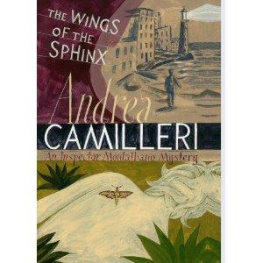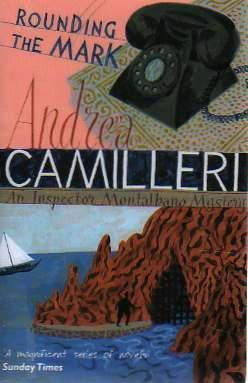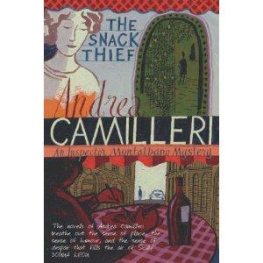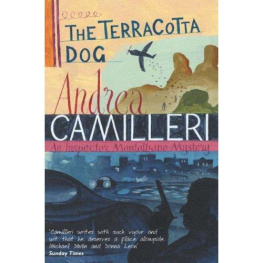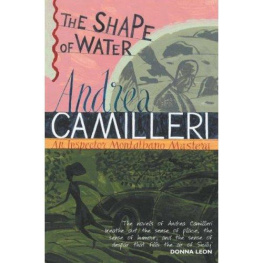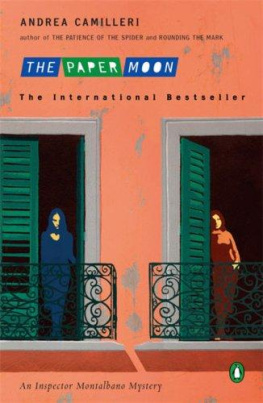MCFARLAND COMPANIONS TO MYSTERY FICTION
1. John Buchan (2009), by Kate Macdonald
2. E.X. Ferrars (2011), by Gina Macdonald with Elizabeth Sanders
3. Ed McBain/Evan Hunter (2012), by Erin E. MacDonald
4. Mary Elizabeth Braddon (2012), by Anne-Marie Beller
5. Andrea Camilleri (2012), by Lucia Rinaldi
A Companion to the
Mystery Fiction
LUCIA RINALDI
McFarland Companions to Mystery Fiction, 5 Elizabeth Foxwell, series editor



vi
The Inspector Montalbano Novels and 11
The Inspector Montalbano Novels and 14
Camilleri's Other Works 17
Camilleri's Other Works 19
Many colleagues and friends made the publication of this work possible. I am grateful to Giuliana Pieri for her friendship and generous assistance; she has been offering her support for my research on Italian mystery fiction for many years. Colleagues at the University College London - in particular, Nicola Ibba and Cristina Massaccesi - tolerated me while I was writing the manuscript and provided useful suggestions and practical help. I also am indebted to Laura Rorato for her friendship and precious advice.
I wish to thank Chiara Restivo at Sellerio for her efficiency and the material she kindly supplied; Alice Gioia at RAI Radio 2 for the invaluable information she provided; and Macmillan, specifically Philippa Hardy, who offered and provided the English editions of Camilleri's Montalbano novels.
I would like to thank Nicola Bilello, Prof. Giuseppe Marci of Cagliari University, Federica Mazzara, and Stephanie Misar at MhZ Networks for the photographic material they kindly provided that is an indispensable feature of this volume. Special thanks go to Pietro Bitto for granting permission to reproduce his beautiful portrait of Andrea Camilleri on the cover.
I am particularly grateful to series editor Elizabeth Foxwell, whose patience and dedication during the editing of this volume have been invaluable.
Special thanks are due to my husband and my family. They have always offered plentiful support and encouragement.
Like many Italians, I became interested in the Sicilian author Andrea Camilleri after watching an episode of Il commissario Montalbano (Inspector Montalbano) on Italian television. The program combined beautiful shots of Sicilian landscapes with a compelling lead character and an intriguing plot. As a huge fan of mystery fiction, I resolved to read the books from which the drama had been adapted, and I found Camilleri's stories based on actual events, playful style, and ironic outlook very original and engaging.
My keen interest in mystery narratives (giallo in Italian) began when I was a teenager, and I used to watch TV detective dramas such as Perry Mason, Columbo, and Charlie's Angels and read novels by Agatha Christie, Arthur Conan Doyle, and Rex Stout. My professional interest in crime narrative developed at university, with my BA thesis (Parma, 1999) on murders in the work of Charles Dickens and the birth of the detective novel in the Victorian age. In the following year, as part of my MA in European literary and cultural studies at Royal Holloway, University of London, I specialized in postmodernism and crime literature, researching contemporary Italian authors such as C. E. Gadda and Umberto Eco. I wrote my MA thesis on eminent Italian writer Leonardo Sciascia, focusing on his detective novels. In 20011 was delighted when the opportunity to write a doctoral thesis on contemporary Italian crime fiction was offered to me. I concentrated on successful writers such as Massimo Carlotto, Marcello Fois, Carlo Lucarelli, and Andrea Camilleri. At the time of the so-called "Camilleri Phenomenon" or the "Camilleri Literary Case," I began my research on his writing, focusing on his mystery novels set in contemporary times featuring Inspector Salvo Montalbano as protagonist.
My research has taken place mainly at my local library; the National Library in Florence; the British Library; University of London libraries; and the library of Royal Holloway, University of London. I also have taken advantage of the vast amount of material that is widely available online such as interviews, articles, videos, and reviews. In particular, the Camilleri Fan Club's Web site offers extensive resources and is constantly updated. I also have made use of the well-organized Web site of Italian state television RAI that allows viewing of video interviews and mystery dramas.
Andrea Camilleri (b. Porto Empedocle, 1925) is the most successful Italian crime writer of the last two decades and, possibly, in the history of Italian mystery fiction. His interest in crime narratives dates back to the 1950s and 1960s when he was working for RAI and contributed to the production of several crime series, including the screen adaptations of the detective novels by Belgian crime writer Georges Simenon for the police drama Le inchieste del commissario Maigret (1964-72). Camilleri published his first written work in 1978, Il torso delle core (Lalli), which was not particularly well received. It was only in the early 1990s that he started to gain a large and devoted following among Italian readers, thanks to his series of detective novels that feature Montalbano and are set in contemporary Sicily. Since then, Camilleri has published a vast number of texts in a wide variety of forms: crime fiction; historical novels (some using mystery fiction techniques); radio and television scripts; plays; short stories; and essays, interviews, and articles on Sicilian and Italian literature, theater, culture, and politics.
According to many critics and commentators, Camilleri's fiction can be divided into two groups: texts set in the present day and historical works. In my view, this is a very limited perception of Camilleri's work. The Sicilian writer has been embracing, deconstructing, and refashioning a number of literary and theatrical genres for his stories. His historical novels, for instance, encompass folktale, mythology, picaresque literature, political commentary, and magical realism and are set in different periods such as the eighteenth century, the postunification years (second half of the nineteenth century), the Fascist regime (from the mid-1920s to the 1940s), and World War II (see Representation of History). The contemporary stories, however, display a less varied time frame; they are mostly based on real events and largely feature Montalbano. In fact, the overwhelming popularity of the Montalbano cycle has been a major source of Camilleri's extraordinary success, notably boosted by the television adaptation Il Commissario Montalbano (Inspector Montalbano) that was first broadcast by RAI Due in 1999 and later shown in the United States. Camilleri's mystery novels are now enjoying increasing popularity worldwide; they have been translated into thirty-seven languages, including Dutch, English, French, German, Greek, Japanese, Portuguese, Spanish, and Swedish.

